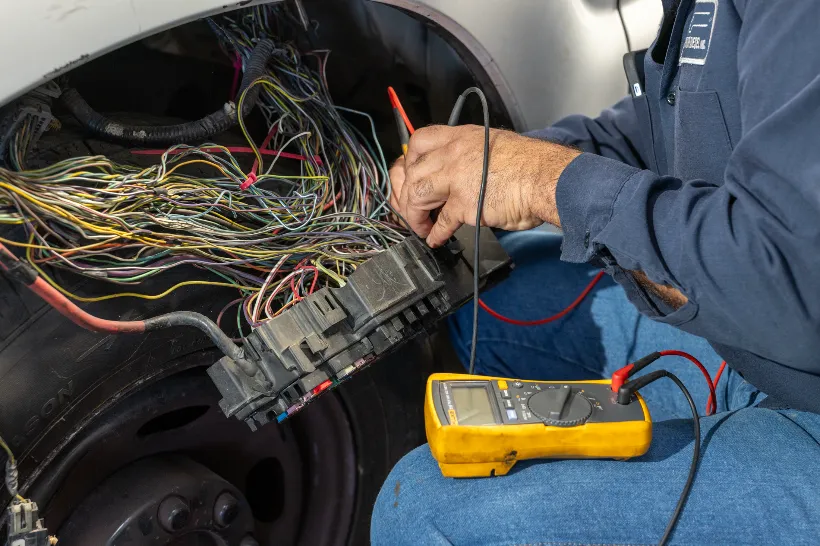
Keeping a grocery fleet running smoothly is no easy task. You need to balance safety, efficiently and sustainably, all while making sure you hit strict delivery schedules. But what’s the secret to nailing this?
Using technology to stay one step ahead. Here, we’ll walk you through seven essential technologies that can transform the performance of your operations, reduce your stress levels, and keep your customers happy.
1. Telematics Systems
Telematics combines GPS technology, real-time diagnostics, and onboard communications to give you an all-in-one, performance-boosting tool. It allows you to monitor driver performance, behavior, and location live. This is essential for any fleet manager, but particularly for grocery fleets, because it allows you to:
- Track delivery routes for timely deliveries
- Monitor driver habits like harsh braking or rapid acceleration, which can damage sensitive cargo
- Reduces fuel consumption, optimizing your bottom line
You can learn more about this topic by checking out our article about the benefits of GPS tracking software.
2. Refrigeration Monitoring Sensors
Refrigeration sensors provide real-time data on the temperature inside your refrigerated trucks. If temperatures exceed safe thresholds, they alert drivers and managers, allowing you to react accordingly. These sensors help prevent the spoiling of perishable goods, reduce waste, boost revenue, and keep customers happy.
By integrating this technology with telematics systems, you can also monitor your refrigeration units remotely, ensuring early intervention if something goes wrong.
3. Electric and Hybrid Vehicles
The green revolution is underway, and sustainability within fleets is becoming increasingly common. Electric and hybrid vehicles reduce carbon emissions and come with long-term fuel savings (and with the price of diesel these days, your budget will thank you).
Operating in densely populated cities, using hybrid or electric vehicles reduces idling in traffic, making them more cost-effective and environmentally friendly. If you’re based in Texas like us, the state has been expanding its electric vehicle charging infrastructure, so fleet owners can now leverage tax incentives for going green.
4. Predictive Maintenance Software
A stitch in time saves nine, and never has that been more true than when it comes to your trucks. Truck preventive maintenance software uses data from sensors and diagnostics to anticipate vehicle breakdowns before they happen. A breakdown can spell disaster for your schedule and perishable goods, making this a smart investment.
5. Fleet Management Apps
Mobile apps for fleet management allow both you and your drivers to stay connected, even when on the go. These apps offer features such as:
- Real-time tracking of deliveries
- Fuel consumption monitoring
- Driver behavior analysis
- Scheduling maintenance checks, the apps can help optimize delivery routes, ensuring trucks take the most efficient paths, reducing delivery time, and saving on fuel costs
6. Electronic Logging Devices (ELDs)
You should already be using an Electronic Logging Device (ELD) anyway, as they’ve been mandated since 2016. This allows you to keep up with your driver’s hours of service (HOS), maintain safety throughout your operations, and stay compliant with regulations.
7. Geofencing Technology
Geofencing creates virtual boundaries around a geographic area. When integrated with fleet management software, geofencing alerts you when a vehicle enters or exits a specific zone. This allows drivers to stick to the most efficient routes, hit delivery times, and save on fuel costs.
It can also enhance warehouse operations by automating the check-in and check-out process when trucks arrive at or depart from distribution centers. This ensures a more streamlined and efficient workflow.
Final Thoughts
Embracing these must-have technologies is no longer optional—it’s essential if you’re looking to maintain a competitive edge in the food and grocery delivery industry. Each tool, from telematics to predictive maintenance software, is critical in ensuring timely, safe, and efficient deliveries. If your fleet hasn’t adopted these technologies, it’s time to switch before your competitors do.
More Articles
.webp)
.webp)
What Are the Main Causes of Brake Failure in Trucks (and How to Prevent Them)
What Are the Main Causes of Brake Failure in Trucks (and How to Prevent Them)
Brake failure is one of the top causes of truck accidents—and it’s often preventable. From air leaks to worn linings and poor adjustments, this guide covers the most common causes and how to avoid them with smart maintenance, inspections, and driver awareness.
.webp)
.webp)
5 Common Tire Maintenance Mistakes That Can Lead to Blowouts
5 Common Tire Maintenance Mistakes That Can Lead to Blowouts
Tire blowouts aren't random—they're preventable. From missed pressure checks to using the wrong tire type, small slip-ups lead to big problems. Learn the 5 most common tire maintenance mistakes that could leave your rig stranded across Rapid City or I-90.


How to Check for Parasitic Draws Draining Your Battery
How to Check for Parasitic Draws Draining Your Battery
A dead battery after downtime? You might be dealing with a parasitic draw—hidden power drains that silently kill your charge. Learn the signs, tools, and step-by-step fixes to track them down, prevent future issues, and keep your fleet running strong and start-ready.
